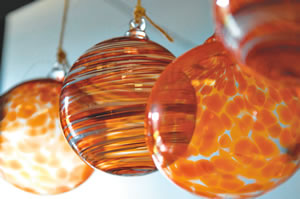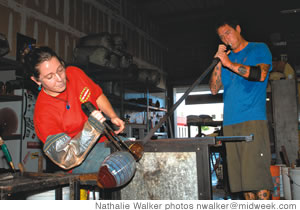THAR THEY BLOW!
Glassblowing is an intense, unforgiving art form that requires confidence in the execution and creation of each individual piece. For the most part, glassblowing techniques and traditions have not wavered with the changing of times, as artists still use the same tools and processes they did centuries ago.

By .(JavaScript must be enabled to view this email address)
E-mail this story | Print this page | Archive | RSS

|
Glassblowing is an intense, unforgiving art form that requires confidence in the execution and creation of each individual piece. For the most part, glassblowing techniques and traditions have not wavered with the changing of times, as artists still use the same tools and processes they did centuries ago.
It is the traditional elements of glassblowing that intrigue and inspire Island Glassworks studio owner Geoff Lee.
“I like how active of an art form it is. It’s real physical, it’s hot,” he says. “I love its connection to tradition. Nothing has really changed regarding the technique and the tools in the last couple thousand years. Everything we are doing here is the same as what artists and craftsmen have been doing for thousands of years. It is just a way to create.”
Artists are very prevalent throughout Hawaii, but glasswork and glassblowing studios are rare, which makes Island Glassworks unique and important to the Islands’ art communities. Lee was introduced to glassblowing while in high school through an elective course offered at Punahou. After receiving a bachelor’s degree in art from the University of Wisconsin-Madison, he began mastering his trade, traveling and working as a glass-blower in Ohio, Seattle, Pennsylvania and Maine. Lee also worked and studied glassblowing at the Centro Studio Vetro in Italy.

|
“Traveling has helped me as an artist because I could go work and observe other glass artists, study with them and be an apprentice for those who were much better than me, and just immerse myself in that and their techniques and art,” says Lee, who earned a master’s in fine arts from the University of Manoa in 2003. It was in 2004 when he opened Island Glass-works in Kailua as a place to create his own art, work with customers on their ideas, as well as rent his studio to other artists as a place for them to master and hone their skills.
A piece of glassblown art starts from a single drop of melted glass and evolves through stages into the finely shaped and solid sculpture that stands on the shelf.
Lee and his assistant Emily Thomas were able to go through, step-by-step, the creation of one of Lee’s signature glass floats, similar to a round, hanging Japanese net float.
The piece starts with melted glass smoldering in a furnace at more than 2,000 degrees F. With a hollow steel pipe, Lee gathers a portion of melted glass onto the tip and begins to roll it on a flat piece of iron, shaping the first layer of glass. “Glass is very dense so it does spread and expand, helping each gathered layer go a long way,” he says.

|
Lee then adds another layer of glass to the original shape, while Thomas begins to blow a pocket of air into the glass, allowing the glass to expand. Glassblowing takes constant turning and revolutions of the glass to shape and form the piece.
After continuous gathering of melted glass layers, blowing and shaping, that single drop of glass has formed a beautiful sphere. Orange melted glass is swirled around the float, adding a rich dimension of color. Lee works to revolve the piece 90 degrees at a time, centering the piece perfectly. To transfer the piece and create the hollow opening for the float, Thomas has a punty, which is essentially another blow pipe with a gathered piece of glass which is then attached to the float. Lee carefully transfers the float to the punty, which will help to create the opening of the float. A pair of cutting shears are used to detached the finished float from the punty glass. Lee explains that the cooling process is gradual, segmenting the glass from its original 2,000 degree state to 1,000 degrees and finally room temperature, a process that may take 10-12 hours.
Lee jokes that it takes 20 years and an hour for a piece to look as it should.
“The techniques have been tweaked as technologies have change. It is the hand tools that have
Page 1 of 2 pages for this story 1 2 >
E-mail this story | Print this page | Comments (0) | Archive | RSS
Most Recent Comment(s):








